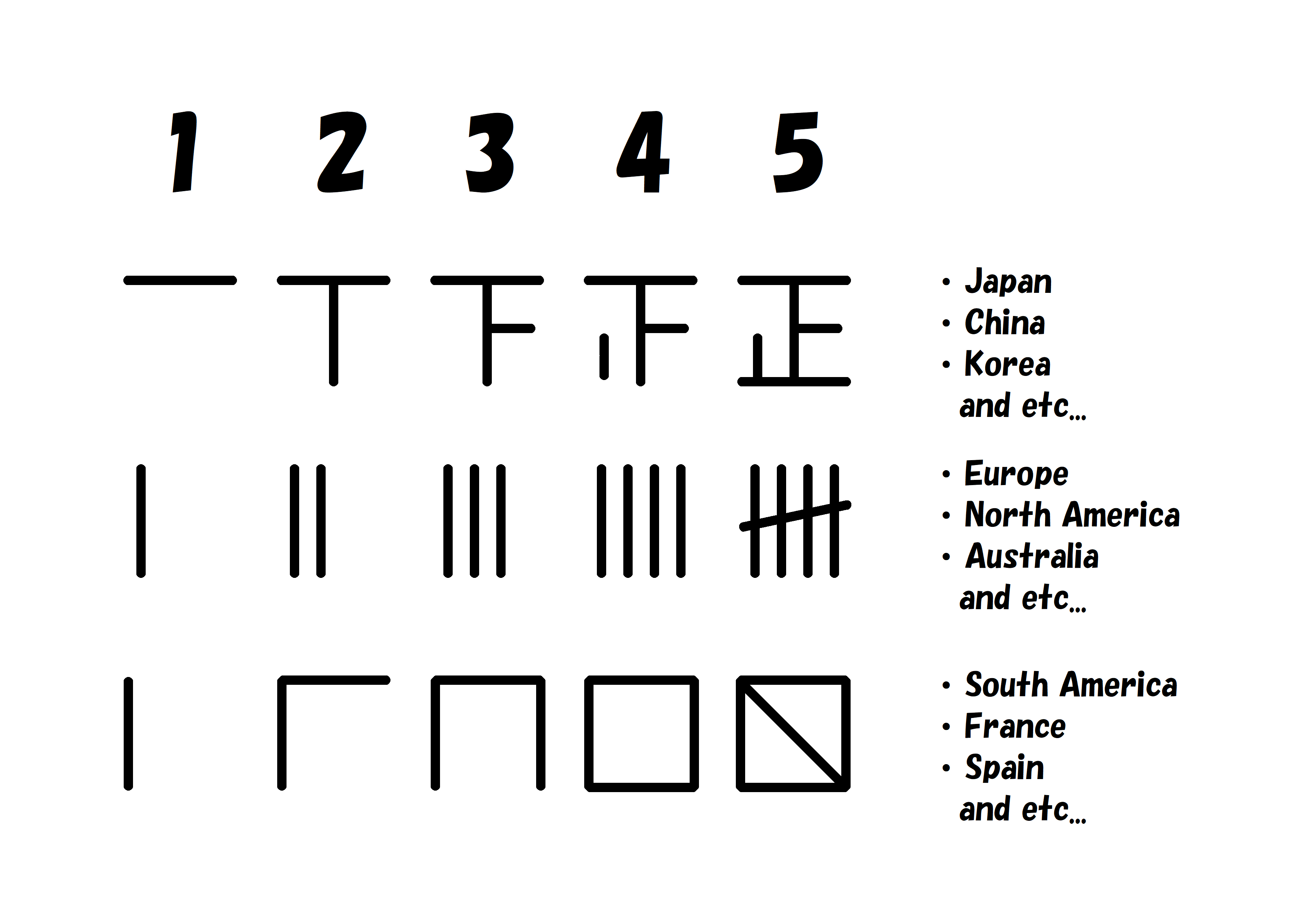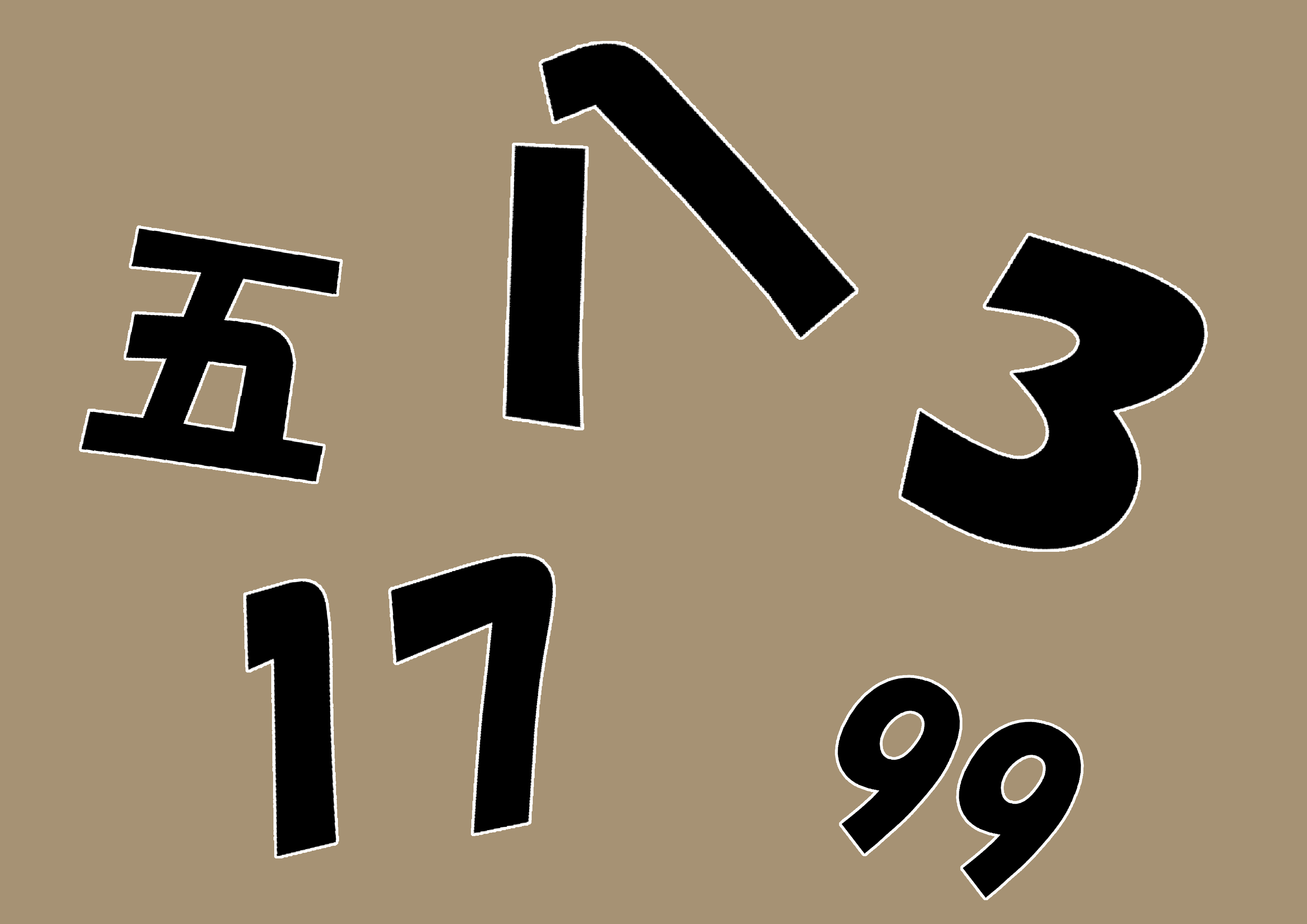In every culture around the world, “number” is one of the most important cultural elements. Each culture has some kind of its own thoughts and perceptions of “number”. For example… If such some kind of its own thoughts and perceptions of “number” are different, the way of counting “number” will also be different, right? In this article, we would like to share with you a few examples of “number” culture that can be found in daily life in Japan.
Counting “numbers”
Although it varies from each language and culture, the way of counting by adding numbers one by one like 1, 2, 3, 4…, is commonly used in all cultures around the world. And also, Counting by decimal numbers, such as 10, 20, 30…, 100, 200, 300…, are often used. The method of counting based on the duodecimal system is also widely used, as in the case of time and calendar, right? In this section, we would like to show you the notation we use to count numbers in increments of 5. This is what is called the “tally marks” way. See the figure below.

After all, each cultural area has a different way of “tally marks”. Which marks do you usually use? The marks for “正” is used in Japan, China, etc. is one of the kanji characters. It is considered to have come into use because it is one of the easiest kanji to write with five strokes, and its notation is easy to read. In Japan, however, the kanji character for “玉” was used until the Edo period (1603-1867). The character for “正” was not used until the Meiji period (1868-1912). Incidentally, in Japan, there are several ways of reading aloud when counting from 1 to 10. Like this…
① Ichi, Ni, San, Shi(Yon), Go, Roku, Shichi(Nana), Hachi, Ku(Kyu), Jyu
② Hitotsu, Futatsu, Mittsu, Yottsu, Itsutsu, Muttsu, Nanatsu, Yattsu, Kokonotsu, To
③ Hi, Fu, Mi, Yo, Itsu, Mu, Nana, Ya, Ko, To
In addition to these, the Japanese language also has numerical notation using kanji characters.
Roman numerals:1, 2, 3, 4, 5, 6, 7, 8, 9, 10
Notation using kanji numerals ①:一, 二, 三, 四, 五, 六, 七, 八, 九, 十
Notation using kanji numerals ②:壱, 弐, 参, 肆, 伍, 陸, 質(漆), 捌, 玖, 拾
※As for the Notation using kanji numerals ②, you do not have to worry because they are rarely used except for “壱”, “弐”, “参”.
We hear that people from overseas are quite surprised when they learn Japanese. In particular, ways of reading aloud ① and ② are often used on a daily basis, so they say that it is quite complicated… Yes. We think they are right.
Thoughts and perceptions about some specific numbers
In Japanese culture, there is a belief that letters and words have a kind of strange power. It is commonly referred to as the “kotodama (word spilit)”. Have you ever heard this word or this kind of thoughts and perceptions before? Although they may be considered important in some religions and other religions, these thoughts or perceptions are not absolute beliefs for all Japanese. However, in today’s Japan, some of them are considered as a kind of common custom or courtesy. “Numbers” are also letters and words. Therefore, we believe that “numbers” have some kinda of “power” as well. These these thoughts or perceptions are often incorporated into “Gen-katsugi (practice superstition)”, in particular. Below we would like to share with you some examples of them.
・1(一):
This number is very important because it has the meaning of “beginning”, “top”, and “only one”. These might be thoughts or perceptions that are also common in other cultures overseas.
・3(三):
Japanese people usually like to narrow it down to three representative examples. Just like, “Big 3 of 〇〇”… Since ancient times, it has been that the Japanese have a tendency to actively adopt overseas cultures and adapt to them rather easily. For better or for worse, there seems to be a tendency not to settle on just one thing about something. It is also considered to prefer the most stable form, as in the concept of the “three-way standoff”. These might be also thoughts or perceptions that are also common in other cultures overseas.
・4(四):
As we have mentioned in other articles, “4(四)” is one of the numbers that are often avoided in Japan. That is often considered an unlucky number. The reason for this is that it reminds us of the word “death” which is read aloud in the same way. In Japanese, “death” is pronounced “shi”, which is the same as the pronunciation of “4(四)”. This is based on the aforementioned belief of the “kotodama (word spilit)”. For the same reason, “9(九)” is also avoided because it is read the same way as “Ku (suffering)”. “42”, “49” are also usually avoided in Japan.
・5(五):
As with “3(三)”, “5(五)” is preferred because it is considered to be a stable form. It is said to be strongly influenced by the ancient Chinese “Five Elements” philosophy, which is known for its belief that all things are composed of the five elements: fire, water, wood, metal, and earth. It is also a word number used in haiku and waka poetry, along with “7(七)”, because of the rhythmic nature of the sound number. As a slight digression, the number of members of a Japanese power ranger hero is very often five.
・7(七):
It is also considered to be a stable number, along with “5(五)”, as the number of words used in haiku and waka poetry. It is Japanese “Five-and-seven syllable meter”. These rhythm numbers are very important for mottoes, slogans, catchphrases, and the like. For example, in Japan, the rainbow is generally considered to have seven colors. The “seven spring flowers” and the “seven gods of good fortune” are also good examples.
・8(八):
In the case of this number, the kanji character for “八” is often focused on. As you can see, the shape of the kanji for “八” extends downward. There is a belief that this shape is good luck (called “sue-hirogari”). “Sue-hirogari” means like “spreading out like an open fan”. In recent years, a new thought that it remind us of “∞” has been added to the number “8(八)”.
・Even numbers:
Apart from individual numbers, “even numbers” are also sometimes considered unlucky in Japan. It is because of that “even numbers” are “divisible” and thus remind us of “parting” or “bankruptcy”. “I” personally think the person who came up with this idea is a very “clever” person… It’s very contrived, isn’t it? However, it is quite well known in Japan as a matter of custom and etiquette, and is often considered very important when it comes to the amount of “congratulatory gifts” for celebrations. You may want to take this opportunity to keep this knowledge in the back of your mind for a moment.
In addition to the above, there are also multiples of 10 and 12, and the thoughts or perceptions that place importance on the same numbers sets such as so-called “snake eyes” and “matching dice”. Even though their meanings or origin may vary, it is interesting to see how the same number can have different meanings and importance in different foreign cultures. Don’t you all think so?




